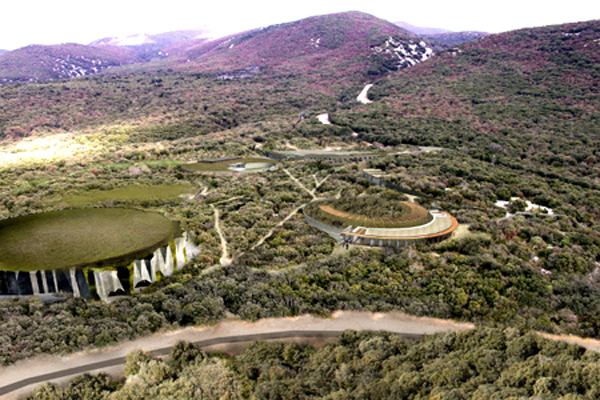


Chauvet Cave in southern is without question a major and unique site. Discovered relatively recently in 1994, it has a rare combination of age , state of preservation, and sheer wealth of art.

For this reason, as part of an initiative led by the Ardeche Local Council, the Rhone-Alpes Region and the Association des Amis de la grotte Chauvet Pont-d'Arc, the French Government has submitted an application for the Chauvet Pont-d'Arc cave to be listed as a UNESCO world heritage site. A decision is expected this summer.
The case seems easy to argue: art depicting lion, cave bear, snow panther, mammoth, white rhinoceros, megaceros, bison, aurochs, ibex, and stag; a seven-metre long panel of horses; a panel depicting a group of lionesses hunting; two rhinoceroses fighting; a lioness spurns the advances of a male; in all, 424 animals. The art itself uses numerous and varied techniques and involves the use of overhangs, hollows, niches and alcoves in the rock itself to give relief and provide perspective.
The only problem with major and unique sites such as Chauvet, Lascaux and Altamira is that they are heavily restricted, for the sake of preservation. Quite rightly of course.
In order to enable the public to enjoy the treasures of the Chauvet cave, a perfect replica has been designed and is currently being built. The Razal site, on the hills of the Vallon-Pont-d'Arc, seven kilometres from the cave, was selected as the location for the replica and is due to open its doors to the public at the end of 2014. It will be the biggest perfect replica of a prehistoric site in Europe. The target is to welcome between 300,000 and 400,000 visitors from around the world each year. Set within a vast wooded area covering 29 hectares, the site will include (alongside the replica cave) a discovery center and a permanent exhibition dedicated to the Aurignacians and parietal art, as well as five sheltered interpretation stations, a temporary exhibition space, an educational area for young people, and an events center.
The designers of the cave replica are working in close collaboration with the scientific team, the challenge being to reproduce the cave and its 8,500 square meters in a space restricted to just 3,500 square meters, while at the same time maintaining the perception of the original volumes. This is made possible by a 3D technique developed using a high-precision scanner to generate a full-scale digital reproduction of the cave. The paintings will be reproduced on a concrete structure with resin coating using natural oxide pigments and Scots pine charcoal. And all the paintings will be done by experienced artists with a view to remaining as faithful as possible to the original spontaneity of t he work.
All five of the visitor's senses will be stimulated during this amazing journey back through time: the coolness, humidity, silence, darkness as well as the subtle mineral aroma which will help fully immerse the public in the cave.
by Bradshaw Foundation
Monday 30 May 2022
by Bradshaw Foundation
Wednesday 19 January 2022
by Bradshaw Foundation
Thursday 06 January 2022
by Bradshaw Foundation
Monday 06 December 2021
by Bradshaw Foundation
Monday 29 November 2021
by Bradshaw Foundation
Monday 25 October 2021
by Bradshaw Foundation
Monday 12 July 2021
by Bradshaw Foundation
Monday 24 May 2021
by Bradshaw Foundation
Tuesday 20 April 2021
by Bradshaw Foundation
Thursday 01 April 2021
by Bradshaw Foundation
Tuesday 23 February 2021
by Bradshaw Foundation
Thursday 14 January 2021
by Bradshaw Foundation
Friday 18 December 2020
by Bradshaw Foundation
Sunday 06 December 2020
by Bradshaw Foundation
Thursday 26 November 2020
by Bradshaw Foundation
Wednesday 07 October 2020
by Bradshaw Foundation
Monday 30 May 2022
by Bradshaw Foundation
Wednesday 19 January 2022
by Bradshaw Foundation
Thursday 06 January 2022
by Bradshaw Foundation
Monday 06 December 2021
by Bradshaw Foundation
Monday 29 November 2021
by Bradshaw Foundation
Monday 25 October 2021
by Bradshaw Foundation
Monday 12 July 2021
by Bradshaw Foundation
Monday 24 May 2021
by Bradshaw Foundation
Tuesday 20 April 2021
by Bradshaw Foundation
Thursday 01 April 2021
by Bradshaw Foundation
Tuesday 23 February 2021
by Bradshaw Foundation
Thursday 14 January 2021
by Bradshaw Foundation
Friday 18 December 2020
by Bradshaw Foundation
Sunday 06 December 2020
by Bradshaw Foundation
Thursday 26 November 2020
by Bradshaw Foundation
Wednesday 07 October 2020
Friend of the Foundation











